USGamer recently published an article about the connections between Castlevania: Symphony of the Night and Castlevania II: Simon’s Quest. In this article, Koji Igarashi is quoted as saying that one idea from Castlevania II that did not come over to Symphony is the idea that the townspeople in Castlevania II lie to the player.
This is not the first time I’ve heard this element of Castlevania II disparaged. I dearly love Castlevania II because the townspeople lied to me! Except, they don’t lie. Not really.
I’ve always been a defender of Castlevania II. When I finally got an NES as a child, I was able to pick five games to go with it (that’s actually a pretty good story that I’ll have to tell some day). The original Castlevania was one of those games. I played it, but I wasn’t very good at it. I eventually made it to the third level, but no farther. I also vividly remember that for whatever reason my NES gripped that game cartridge incredibly tight and I would always have to ask my mom or dad to pull it out of my NES before I could play something else. The combination of those two facts lead me not to play the original Castlevania all that much. Since I wasn’t particularly attached to the game, when the sequel came out, I let it pass. It wasn’t my thing.
Eventually I ended up with a copy of Castlevania II through a trade. The specifics are lost to time, but I figured I had the game, I might as well play it. Immediately, I was struck by how good that game felt. The graphics were noticeably better than the original Castlevania. Simon’s jump felt much more fluid and controllable. Even killing the enemies had a more satisfying feel to it. Also, I could wander around. I wasn’t trapped in a level system. This entire world was open for me to explore. It caught my imagination. I spent so much time exploring that world. I remember the clue from the first town.

I didn’t heed the clue. Instead, I just kept wandering and exploring. Eventually I happened upon the first castle and ran into a dead end.

Obviously, there was something I was missing. Well, I guess there’s a clue in Veros (spoiler alert: today, having grown up on video games, I think I would put together the fact that you get the white crystal in the first town, golly gee, maybe that’s going to have something to do with it).
In Veros you learn:

Now we’re cooking. Back at Berkley Mansion:

Huzzah!
Honestly, pretty much the rest of Castlevania II unfolds this same way. Yes, it requires some obtuse exploring (when I was ten I didn’t mind throwing holy water on literally ever block I came across). But the clues are there in the game, presented as riddles. They’re not presented as lies. They’re not even that poorly translated, which is a common complaint.

Yep. The Japanese text really does say “duck.” While researching this mistranslation argument further, I found very little that was truly mistranslated and any dialog that might be construed as such could still be interpreted as a valid clue.
I contend that this is not lying, not mistranslation, but world-building. Rumor and innuendo are often not specific and open to interpretation, the fact that this was reflected in a video game– something that was supposed to be transparently helpful–was a revelation to me. Very quickly I changed my expectations as a player. I didn’t expect the game to hand everything to me, so I was willing (and I had the time) to explore and put things together and actually earn an accomplishment. When I saw that moving platform after equipping the white crystal in the Berkley Mansion, I felt smarter than Sherlock Holmes!
I think that people are just conditioned to play a different type of game. With tutorials, optional difficulty levels, and the game sometimes literally taking control away from us, the idea of a game that puts so much on the player can be a turn off (Dark Souls crowd excepted). Now I will agree that the idea of throwing holy water everywhere to see what you’ll find is an archaic design, but there’s so much that Castlevania II got right in terms of hints while still allowing the player to discover.
Castlevania II was the first Castlevania game that added RPG elements to the mix. If you did puzzle out the game, by the time to had to fight anything substantial (insert joke about easy bosses here) you were well equipped to handle it.
My final defense of Castlevania II is something that I think everyone can agree on: Kenichi Matsubara’s score. From “Bloody Tears” to “Within These Castle Walls,” it is a stunningly good piece of work with many of these themes being weaved throughout Castlevania games ever since.
As we approach the 30th Anniversary of Castlevania II’s US release date, I’m sure many words will be written and said. I hope they will be fair words. I’m not sure this game has always received a fair shake from players. It is an excellent game with a really joyful sense of discovery.
Sincerely,
The Storyteller

